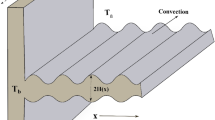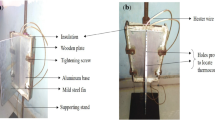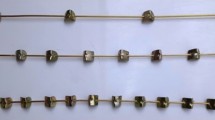Abstract
In this study, an artificial neural network (ANN) model was applied to predict the thermo-hydraulic performance of the offset-strip fin heat exchanger. The ANN model was used for predicting the thermo-hydraulic performance to improve the prediction accuracy and extend the applicable range compared to the results of using the empirical equations reported in previous studies. The main parameters of these empirical equations were fin height (0.134 < α < 0.997), fin length (0.012 < δ < 0.048), fin width (0.041 < γ < 0.121), and Reynolds number (120 < Re <104). In addition, the Fanning friction factor f and the Colburn factor j were considered as the outputs of the ANN model. The impact of the parameters on the thermo-hydraulic performance of the heat exchanger was quantitatively evaluated, and the prediction accuracy was improved over a wide range for the thermo-hydraulic performance generated by the ANN model. Thus, the results obtained using the ANN model agreed well with the experimental data over a wider range than possible for the previous empirical correlations, showing extremely high accuracy and validity of the ANN model in comparison to the empirical equations.
Similar content being viewed by others
Abbreviations
- B :
-
Bias vector
- c p :
-
Specific heat
- D h :
-
Hydraulic diameter of fin
- f :
-
Fanning friction factor
- j :
-
Colburn factor
- G :
-
Mass flux
- h :
-
Fin height
- I :
-
Relative impact
- l :
-
Fin length
- Pr :
-
Prandtl number
- q :
-
Heat flux
- t :
-
Fin thickness
- R 2 :
-
Coefficient of regression
- Re :
-
Reynolds number
- RMRE :
-
Root mean relative error
- RMSE :
-
Root-mean-square error
- St :
-
Stanton number
- T :
-
Temperature
- w :
-
Fin width
- W :
-
Weight
- α :
-
Dimensionless fin height
- β :
-
Thermal expansion coefficient
- δ :
-
Dimensionless fin length
- γ :
-
Dimensionless fin width
- σ err :
-
Standard deviation for relative error
- τ :
-
Wall shear stress
- λ :
-
Thermal conductivity
- μ :
-
Dynamic viscosity
- ρ :
-
Density
- w :
-
Wall
- m :
-
Average
References
K. H. Do, B. Choi, Y. Han and T. Kim, Experimental investigation on the pressure drop and heat transfer characteristics of a recuperator with offset strip fins for a micro gas turbine, International Journal of Heat and Mass Transfer, 103 (2016) 457–467.
Y. Yin, X. Zhang, G. Wang and L. Luo, Experimental study on a new internally cooled/heated dehumidifier/regenerator of liquid desiccant systems, Intenational Journal of Refrigeration, 31 (2008) 857–866.
W. M. Kays and A. L. London, Compact Heat Exchangers, 3rd Ed., New York (1984).
S. V. Manson, Correlations of Heat Transfer Data and of Friction Data for Interrupt Plain Fins Staggered in Successive Rows, NACA Tech. Note 2237, NACA, Washington (1950).
A. R. Wieting, Empirical correlation for heat transfer and flow friction characteristics of rectangular offset-fin plate-fin heat exchangers, Journal of Heat Transfer, 97 (1975) 488–490.
H. M. Joshi and R. L. Webb, Heat transfer and friction in the offset strip fin heat exchanger, International Journal of Heat and Mass Transfer, 30 (1987) 69–84.
S. Mochizuki and Y. Yagi, Transport phenomena in stacks of interrupt parallel-plate surface, Experimental of Heat Transfer, 1 (1987) 127–140.
E. V. Dubrovsky and V. Y. Vasiliev, Enhancement of convective heat transfer in rectangular ducts of interrupted surfaces, International Journal of Heat and Mass Transfer, 31 (1988) 807–818.
R. M. Manglik and A. E. Bergles, Heat transfer and pressure drop correlations for the rectangular offset strip fin compact heat exchanger, Experimental Thermal Fluid Science, 10 (1995) 171–180.
N. C. Dejong, L. W. Zhang, A. M. Jacobi, S. Balachandar and D. K. Tafti, A complementary experimental and numerical study of the flow and heat transfer in offset strip-fin heat exchangers, Journal of Heat Transfer, 120 (1998) 690–698.
Y. C. Chang, Sequencing of chillers by estimating chiller power consumption using artificial neural networks, Building and Environment, 42 (2007) 180–188.
M. Hosoz and M. H. Ertunc, Artificial neural network analysis of an automobile airconditioning system, Energy Conversion and Management, 47 (2006) 574–587.
O. Ramzi, Building shape optimization using neural network and genetic lgorithm approach, ASHRAE Transactions, 112 (2006) 484–491.
C. G. Juan, O. D. Jose and U. Gustavo, Film cooling optimization on leading edge gas turbine blade using differential evolution, Journal of Aerospace Engineering, 233 (2019) 1656–1666.
P. V. Arturo, S. Mirhir, K. T. Yang and M. L. Rodney, Neural network analysis of fin-tube refrigerating heat exchanger with limited experimental data, International Journal of Heat and Mass Transfer, 44 (2001) 763–770.
D. Gerardo, S. Mirhir, K. T. Yang and M. L. Rodney, Simulation of heat exchanger performance by artificial neural networks, HVAC&R Research, 5 (2011) 195–208.
M. H. Esfe, Designing a neural network for predicting the heat transfer and pressure drop characteristics of Ag/water nanofluids in a heat exchanger, Applied Thermal Engineering, 126 (2017) 559–565.
S. R. Patra, R. Jehadeesan, S. Rajeswari and S. A. V. Satyamurthy, Artificial neural network model for intermediate heat exchanger of nuclear reactor, International Journal of Computer Applications, 1 (2010) 63–69.
A. L. London and R. K. Shah, Offset rectangular plate-fin surfaces-heat transfer and flow friction characteristics, Journal of Engineering and Power, 90 (1968) 218–228.
F. M. Walters, Hypersonic Research Engine Project - Phase IIA, Category I Test Report on Fin Heat Transfer and Pressure Drop Testing, Data Item No. 63.02, AiResearch Manufacturing Co., Doc. AP-69-5348 (1969).
A. L. London and C. K. Ferguson, Test results of high-performance heat-exchanger surfaces used in aircraft inter-coolers and their significance for gas-turbine regenerator design, Trans. ASME, 71 (1949) 17–26.
R. H. Norris and W. A. Spofford, High-performance fins for heat transfer, Trans. ASME, 64 (1942) 489–496.
U. T. Joyner, Experimental Investigation of Entrance Region Heat Transfer Coefficients, NACA ARR 3K01, NACA, Washington (1943).
E. K. Kalinin, G. A. Dreitser and E. V. Dubrovsky, Compact tube and plate-finned heat exchangers, Heat Transfer Engineering, 6 (1985) 44–51.
Acknowledgments
This research was partly supported by the National Research Foundation of Korea (NRF) grant funded by the Korea government (MSIT) [NRF-2019R1A5A8083201]. This work was partly supported by Korea Institute of Energy Technology Evaluation and Planning (KETEP) grant funded by the Korea government (MOTIE) (20193310100050, Technology development of gas turbine blade reengineering specialized for domestic operating environment).
Author information
Authors and Affiliations
Corresponding author
Additional information
Sangmin Kim received his undergraduate degree from Pusan National University, South Korea in 2018. Currently, he is pursuing integrated Ph.D. at Pusan National University, Korea. His research interests are focused on Heat Exchanger, finite volume method, gas turbine blade, ANN and computational fluid dynamics.
Sudhanshu Pandey received his M.S. degree from Indian Institute of Technology Madras, India in 2016, and pursuing Ph.D. from Pusan National University, Korea. His research interests are focused on natural convection, non-Newtonian fluids and computational fluid dynamics.
Man Yeong Ha received his B.S. degree from Pusan National University, Korea, in 1981, M.S. degree, in 1983, from Korea Advanced Institute of Science and Technology, Korea, and Ph.D. degree from Pennsylvania State University, USA in 1990. Dr. Ha is currently a Professor at the School of Mechanical Engineering at Pusan National University in Busan, Korea. He served as an Editor of the Journal of Mechanical Science and Technology. He is the member of Honorary Editorial Advisory Board of the International Journal of Heat and Mass Transfer. His research interests are focused on thermal management, computational fluid dynamics, and micro/nano fluidics.
Rights and permissions
About this article
Cite this article
Kim, S., Seo, Y.M., Yoon, S.Y. et al. Thermo-hydraulic performance prediction for offset-strip fin heat exchangers using artificial neural networks. J Mech Sci Technol 37, 2623–2638 (2023). https://doi.org/10.1007/s12206-023-0436-3
Received:
Revised:
Accepted:
Published:
Issue Date:
DOI: https://doi.org/10.1007/s12206-023-0436-3




